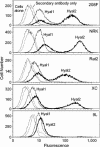Improved enzootic nasal tumor virus pseudotype packaging cell lines reveal virus entry requirements in addition to the primary receptor Hyal2
- PMID: 15596804
- PMCID: PMC538734
- DOI: 10.1128/JVI.79.1.87-94.2005
Improved enzootic nasal tumor virus pseudotype packaging cell lines reveal virus entry requirements in addition to the primary receptor Hyal2
Abstract
Enzootic nasal tumor virus (ENTV) and jaagsiekte sheep retrovirus (JSRV) are closely related retroviruses that cause epithelial cancers of the respiratory tract in sheep and goats. Both viruses use the glycosylphosphatidylinositol (GPI)-anchored cell surface protein hyaluronidase 2 (Hyal2) as a receptor for cell entry, and entry is mediated by the envelope (Env) proteins encoded by these viruses. Retroviral vectors bearing JSRV Env can transduce cells from a wide range of species, with the exception of rodent cells. Because of the low titer of vectors bearing ENTV Env, it has been difficult to determine the tropism of ENTV vectors, which appeared to transduce cells from sheep and humans only. Here we have developed high-titer ENTV packaging cells and confirm that ENTV has a restricted host range compared to that of JSRV. Most cells that are not transduced by JSRV or ENTV vectors can be made susceptible following expression of human Hyal2 on the cells. However, five rat cell lines from different rat strains and different tissues that were engineered to express human Hyal2 were still only poorly infected by ENTV vectors, even though the ENTV Env protein could bind well to human Hyal2 expressed on four of these cell lines. These results indicate the possibility of a coreceptor requirement for these viruses.
Figures





Similar articles
-
Role of virus receptor Hyal2 in oncogenic transformation of rodent fibroblasts by sheep betaretrovirus env proteins.J Virol. 2003 Mar;77(5):2850-8. doi: 10.1128/jvi.77.5.2850-2858.2003. J Virol. 2003. PMID: 12584308 Free PMC article.
-
Mechanism of cell entry and transformation by enzootic nasal tumor virus.J Virol. 2002 Mar;76(5):2141-9. doi: 10.1128/jvi.76.5.2141-2149.2002. J Virol. 2002. PMID: 11836391 Free PMC article.
-
Envelope-induced cell transformation by ovine betaretroviruses.J Virol. 2002 Jun;76(11):5387-94. doi: 10.1128/jvi.76.11.5387-5394.2002. J Virol. 2002. PMID: 11991967 Free PMC article.
-
Identification of Hyal2 as the cell-surface receptor for jaagsiekte sheep retrovirus and ovine nasal adenocarcinoma virus.Curr Top Microbiol Immunol. 2003;275:179-99. doi: 10.1007/978-3-642-55638-8_7. Curr Top Microbiol Immunol. 2003. PMID: 12596899 Review.
-
Hyaluronidase 2 and its intriguing role as a cell-entry receptor for oncogenic sheep retroviruses.Semin Cancer Biol. 2008 Aug;18(4):296-301. doi: 10.1016/j.semcancer.2008.03.010. Epub 2008 Mar 26. Semin Cancer Biol. 2008. PMID: 18485731 Free PMC article. Review.
Cited by
-
Experimental transmission of enzootic nasal adenocarcinoma in sheep.Vet Res. 2013 Jul 30;44(1):66. doi: 10.1186/1297-9716-44-66. Vet Res. 2013. PMID: 23899161 Free PMC article.
-
Retroviral vectors: from cancer viruses to therapeutic tools.Hum Gene Ther. 2014 Dec;25(12):989-94. doi: 10.1089/hum.2014.2542. Hum Gene Ther. 2014. PMID: 25458252 Free PMC article. Review. No abstract available.
-
Jaagsiekte sheep retrovirus and enzootic nasal tumor virus promoters drive gene expression in all airway epithelial cells of mice but only induce tumors in the alveolar region of the lungs.J Virol. 2011 Aug;85(15):7535-45. doi: 10.1128/JVI.00400-11. Epub 2011 May 18. J Virol. 2011. PMID: 21593165 Free PMC article.
-
Host species barriers to Jaagsiekte sheep retrovirus replication and carcinogenesis.J Virol. 2013 Oct;87(19):10752-62. doi: 10.1128/JVI.01472-13. Epub 2013 Jul 31. J Virol. 2013. PMID: 23903827 Free PMC article.
-
Enhancement of enveloped virus entry by phosphatidylserine.J Virol. 2005 Sep;79(17):11496-500. doi: 10.1128/JVI.79.17.11496-11500.2005. J Virol. 2005. PMID: 16103200 Free PMC article.
References
-
- Barker, M., T. Hoshino, O. Gurcay, C. B. Wilson, S. L. Nielsen, R. Downie, and J. Eliason. 1973. Development of an animal brain tumor model and its response to therapy with 1,3-bis(2-chloroethyl)-1-nitrosourea. Cancer Res. 33:976-986. - PubMed
Publication types
MeSH terms
Substances
Grants and funding
LinkOut - more resources
Full Text Sources
Other Literature Sources

